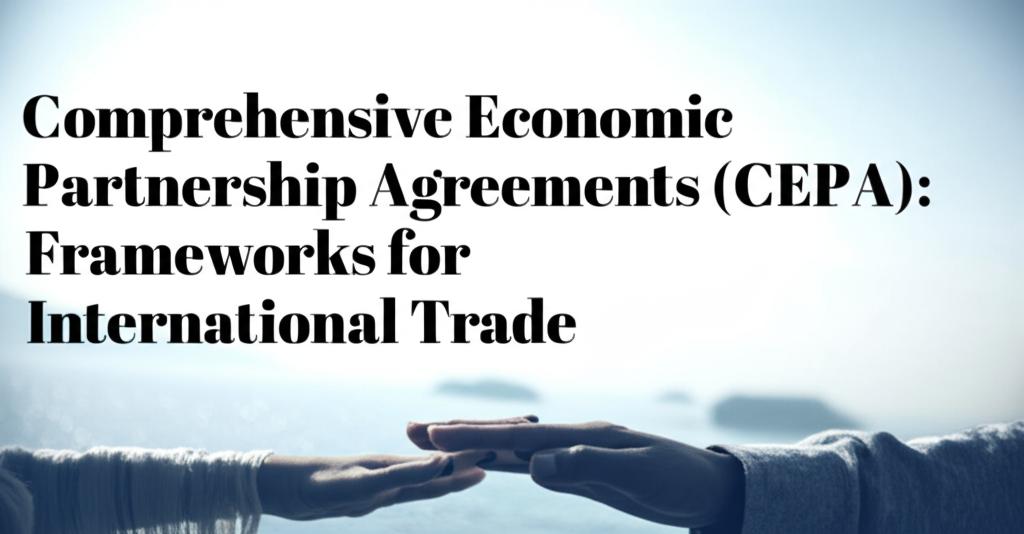Comprehensive Economic Partnership Agreements (CEPAs) are transforming the landscape of international trade. These agreements go beyond traditional Free Trade Agreements (FTAs) by covering a wider range of economic activities and fostering deeper integration between partner countries.
Core Features and Benefits of CEPAs:CEPAs are designed to be comprehensive, addressing multiple facets of economic collaboration. Key components and their advantages include:
- Enhanced Market Access: CEPAs aim to significantly reduce or eliminate tariffs on a vast majority of goods traded between partner nations. For instance, the recently signed Vietnam-UAE CEPA will see the UAE and Vietnam progressively eliminate tariffs on 99% and 98.5% of each other's exports, respectively. This enhanced market access boosts exports and provides consumers with a wider variety of goods at potentially lower prices.
- Trade in Services: Unlike many traditional FTAs that focus heavily on goods, CEPAs typically include robust provisions for liberalizing trade in services. This opens up opportunities in sectors like finance, education, tourism, and professional services.
- Investment Promotion and Protection: A crucial element of CEPAs is the inclusion of measures to encourage and protect foreign investment. This involves creating a stable and predictable legal framework for investors, which can include provisions on non-discrimination, protection against expropriation without fair compensation, and dispute settlement mechanisms.
- Simpler Customs Procedures: CEPAs often include commitments to streamline and harmonize customs procedures. This reduces red tape, speeds up the clearance of goods, and lowers transaction costs for businesses. Modern approaches like invoice declaration of origin instead of traditional certificates of origin are sometimes adopted.
- Rules of Origin: Clear and modern rules of origin are established to determine which goods qualify for preferential treatment under the agreement, making it easier for exporters to comply.
- Technical Barriers to Trade (TBT) and Sanitary and Phytosanitary (SPS) Measures: CEPAs address non-tariff barriers by including provisions on technical regulations, standards, and health and safety measures, ensuring they are not used as disguised protectionism and are based on international standards where possible.
- Intellectual Property Rights (IPR): Provisions related to the protection and enforcement of intellectual property rights are common, fostering innovation and creativity.
- Digital Trade: Recognizing the growing importance of the digital economy, newer CEPAs often include chapters on digital trade. These can cover areas like cross-border data flows, e-commerce, consumer protection online, and cybersecurity cooperation, and may prohibit requirements for local data storage.
- Economic and Technical Cooperation: Many CEPAs incorporate frameworks for collaboration in various economic sectors, encouraging knowledge sharing, capacity building, and joint initiatives. This can extend to areas like sustainable development, renewable energy, and infrastructure.
- Support for Small and Medium-Sized Enterprises (SMEs): Some CEPAs include specific chapters or provisions aimed at helping SMEs participate in and benefit from international trade, such as promoting access to information, finance, and digital tools.
- Dispute Settlement: Robust mechanisms for resolving disputes between partner countries regarding the interpretation or application of the agreement are a standard feature.
- Government Procurement: CEPAs may open up government procurement markets to businesses from partner countries, creating new commercial opportunities.
While both CEPAs and FTAs aim to liberalize trade, CEPAs are generally broader in scope. FTAs traditionally focus primarily on reducing tariffs and other barriers to trade in goods. CEPAs, on the other hand, encompass a wider array of economic aspects, including services, investment, intellectual property, digital trade, and economic cooperation, aiming for deeper economic integration. In essence, CEPAs are often described as being "more ambitious" than traditional FTAs.
Recent Trends and Examples:Countries are increasingly pursuing CEPAs to diversify their trade relationships and access new markets. The United Arab Emirates (UAE) has been particularly active in this area, signing CEPAs with India, Israel, Indonesia, Türkiye, Cambodia, Georgia, Costa Rica, Mauritius, Vietnam, and Australia, with more under negotiation. These agreements are a key part of the UAE's "Projects of the 50" initiative, aimed at driving sustainable development and positioning the nation as a global trade and logistics hub.
The Vietnam-UAE CEPA, for example, is Vietnam's first free trade agreement with an Arab country and is expected to enhance cooperation across various sectors, including tourism, manufacturing, and energy development, particularly in Vietnam's expanding renewable energy sector. Similarly, the Australia-UAE CEPA focuses on enhancing investment, with specific MOUs covering areas like data centers, AI, food and agriculture, green energy, infrastructure, and the minerals sector.
The Indonesia-Canada CEPA aims to significantly boost bilateral trade and foster investment by addressing market access, investment protection, and sustainable development.
Evolution and Future:The framework of CEPAs continues to evolve. Modern agreements increasingly incorporate provisions related to:
- Sustainable Development: Including considerations for environmental protection and labor rights.
- Digital Economy: Adapting to the rapid growth of digital trade and new technologies like AI.
- Inclusivity: Promoting the participation of underrepresented groups, such as women and Indigenous peoples, in international trade. For example, the Australia-UAE CEPA includes a stand-alone chapter on promoting First Nations trade and investment interests.
- Resilient Supply Chains: Aiming to secure and diversify supply chains, a lesson learned from recent global disruptions.
As global economic interdependence grows, CEPAs are likely to become even more crucial as frameworks for structuring international trade relationships, fostering deeper economic cooperation, and driving sustainable growth. They represent a shift towards more comprehensive and integrated approaches to international economic partnerships.

